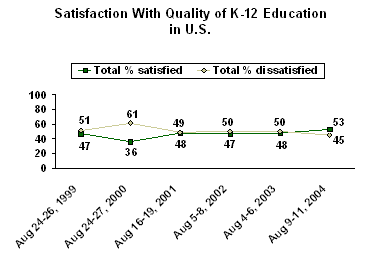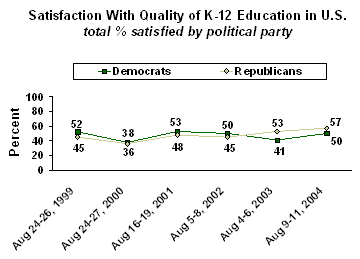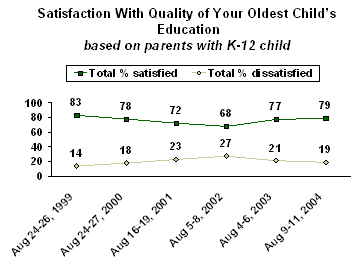GALLUP NEWS SERVICE
PRINCETON, NJ -- With school having started or soon to start for children across the country, Â鶹´«Ã½AV's annual Work and Education poll finds satisfaction with K-12 education in the United States increasing, to the highest point Â鶹´«Ã½AV has measured since 1999. Americans believe improving teacher quality is the best way to improve K-12 education in the United States, along with reducing class size and emphasizing a basic curriculum. Parents of school-age children continue to show even higher levels of satisfaction with the education their own children are receiving.
The poll, conducted Aug. 9-11, finds 53% of Americans satisfied and 45% dissatisfied with "the quality of education students receive in kindergarten through grade 12 in the U.S. today." That represents an increase in satisfaction of five percentage points from last year, and is the highest since 1999, when Â鶹´«Ã½AV first asked the question. Educational satisfaction had been as low as 36% in 2000, when it was a key election issue.

The following table demonstrates that the increase in satisfaction is fairly broad-based -- most demographic groups show slightly higher satisfaction scores today than in 2003. The largest increases are seen among rural residents, those with a high school education or less, senior citizens, nonwhites, and Democrats. But for these groups, the size of the increase is somewhat overstated given that their 2003 satisfaction levels were atypically low, and their satisfaction in 2004 is basically a return to previous levels. For example, in 2002, 56% of rural residents and 50% of Democrats were satisfied with K-12 education.
Change in Satisfaction With K-12 Education in United States, 2003 vs. 2004
|
Group |
Satisfaction, 2003 |
Satisfaction, 2004 |
Change |
|
|
% |
% |
pct. pts. |
|
Men |
47 |
51 |
+4 |
|
Women |
49 |
54 |
+5 |
|
|
|
|
|
|
White |
50 |
54 |
+4 |
|
Nonwhite |
39 |
48 |
+9 |
|
|
|
|
|
|
18-29 years old |
58 |
54 |
-4 |
|
30-49 years old |
50 |
54 |
+4 |
|
50-64 years old |
42 |
49 |
+7 |
|
65 and older |
42 |
52 |
+10 |
|
|
|
|
|
|
East |
51 |
56 |
+5 |
|
Midwest |
54 |
54 |
0 |
|
South |
47 |
54 |
+7 |
|
West |
39 |
46 |
+7 |
|
|
|
|
|
|
Urban |
48 |
45 |
-3 |
|
Suburban |
48 |
53 |
+5 |
|
Rural |
46 |
61 |
+15 |
|
|
|
|
|
|
High school education or less |
50 |
61 |
+11 |
|
College educated |
46 |
47 |
+1 |
|
|
|
|
|
|
Democrat |
41 |
50 |
+9 |
|
Independent |
50 |
50 |
0 |
|
Republican |
53 |
57 |
+4 |
|
|
|
|
|
|
Liberal |
45 |
44 |
-1 |
|
Moderate |
47 |
53 |
+6 |
|
Conservative |
51 |
57 |
+6 |
|
|
|
|
|
|
Have child in grade K-12 |
54 |
57 |
+3 |
|
No children in grade K-12 |
45 |
51 |
+6 |
For the second consecutive year, Republicans have shown higher levels of satisfaction than Democrats, as President Bush's education reforms have begun to take hold. The pattern is fairly typical in a general sense, in that partisans generally rate conditions on a variety of factors in the country more positively when a member of their party occupies the White House.

A separate survey, the annual Phi Delta Kappa/Â鶹´«Ã½AV Poll of the Public's Attitudes Toward the Public Schools, approaches its measurement of educational satisfaction in a different manner. It asks Americans to assign a letter grade to public schools nationally (the "satisfaction" question discussed previously does not focus its ratings on public schools alone). This year, 26% of Americans give the public schools an A or B grade, unchanged from last year. Consistent with previous years, the survey finds much higher ratings of public schools in respondents' communities -- 47% give local public schools an A or B grade.
Improving National Education
The Aug. 9-11 Â鶹´«Ã½AV Poll asked Americans to say, in their own words, what would be the best way to improve K-12 education in the United States. The most frequently given responses focus on teacher quality (15%), reducing class size (11%), and returning to a more basic curriculum of reading, writing, and arithmetic (10%). Other common responses are to improve school funding (7%), have greater parental involvement (6%), and increase teacher pay (6%).
Just your opinion, what would be the best way to improve kindergarten through 12th grade education in the U.S. today? [OPEN-ENDED]
|
|
2004 Aug 9-11 |
|
|
% |
|
Quality teachers/better educated/more involvement/caring |
15 |
|
Reduce number of children in classroom |
11 |
|
Back to the basic curriculum (reading, writing, arithmetic) |
10 |
|
Improve school funding |
7 |
|
Better pay for the teachers |
6 |
|
More parental involvement |
6 |
|
Better discipline in schools |
5 |
|
Hire more teachers |
5 |
|
Improve standards for testing |
2 |
|
Stop the government from running schools/get rid of No Child Left Behind |
2 |
|
More schools/improved schools |
2 |
|
School vouchers |
2 |
|
Teach more about real life/how to survive |
2 |
|
More resources in the schools for teaching |
1 |
|
Year-round schooling |
1 |
|
Better security/safer schools |
1 |
|
Spend more time in school |
1 |
|
Get rid of/abolish teachers' unions or the NEA |
1 |
|
Put God back in school |
1 |
|
|
|
|
Other |
7 |
|
None |
2 |
|
No opinion |
10 |
Ratings of Own Children's Education
According to the Work and Education poll, about one in three U.S.
adults (30%) have a child who will attend kindergarten through 12th
grade this fall. Of those, 40% will send their oldest child to high
school (grades 9 through 12), 21% to middle school (grades 6
through 8), and 38% to elementary school (kindergarten through the
5th grade). The vast majority of those children, 86%, will be in a
public school, while 7% will attend a private school, 4% will be
enrolled in a parochial school, and 2% will be home-schooled.
Most parents of school-age children are satisfied with their oldest child's education -- 79% say they are satisfied, including 32% who are "completely satisfied." With one exception (in 2002), more than 7 in 10 parents have expressed satisfaction with their child's education since this was first measured in 1999.

Public-school parents are no different from all parents in their assessment of their eldest child's education -- 78% are satisfied, including 30% who are completely satisfied. The Phi Delta Kappa poll also shows high levels of satisfaction among public school parents, 70% of whom give their oldest child's school an A or B grade.
Survey Methods
Results for the Â鶹´«Ã½AV Work and Education poll are based on telephone interviews with a randomly selected national sample of 1,017 adults, aged 18 and older, conducted Aug. 9-11, 2004. For results based on this sample, one can say with 95% confidence that the maximum error attributable to sampling and other random effects is ±3 percentage points. In addition to sampling error, question wording and practical difficulties in conducting surveys can introduce error or bias into the findings of public opinion polls.
For results based on the sample of 291 parents with children in kindergarten through 12th grade, the maximum margin of sampling error is ±6 percentage points.
For results based on the sample of 249 parents with children in public schools, the maximum margin of sampling error is ±7 percentage points.
Results for the Phi Delta Kappa/Â鶹´«Ã½AV Poll of the Public's Attitudes Toward the Public Schools are based on telephone interviews with a randomly selected national sample of 1,003 adults, aged 18 and older, conducted May 28-June 18, 2004. For results based on this sample, one can say with 95% confidence that the maximum error attributable to sampling and other random effects is ±3 percentage points.
In addition to sampling error, question wording and practical difficulties in conducting surveys can introduce error or bias into the findings of public opinion polls.
Next, we have some questions on the subject of education. First,
27. Overall, how satisfied are you with the quality of education students receive in kindergarten through grade 12 in the U.S. today -- would you say you are completely satisfied, somewhat satisfied, somewhat dissatisfied or completely dissatisfied?
|
|
Com- |
Some- |
Some- |
Com- |
No |
|
|
% |
% |
% |
% |
% |
|
2004 Aug 9-11 |
10 |
43 |
32 |
13 |
2 |
|
|
|
|
|
|
|
|
2003 Aug 4-6 |
8 |
40 |
34 |
16 |
2 |
|
2002 Aug 5-8 |
7 |
40 |
32 |
18 |
3 |
|
2001 Aug 16-19 |
10 |
38 |
32 |
17 |
3 |
|
2000 Aug 24-27 |
7 |
29 |
40 |
21 |
3 |
|
1999 Aug 24-26 |
8 |
39 |
38 |
13 |
2 |
In terms of your family,
D21. Do you have any children who will be attending school in kindergarten through grade 12 this year?
|
|
Yes |
No |
No opinion |
|
|
|
|
|
|
2004 Aug 9-11 |
30% |
70 |
* |
|
* Less than 0.5% |
|||
For the next series of questions, we'd like you to think about your oldest child who will be attending kindergarten through grade 12 this year.
28. Thinking about your oldest child in kindergarten through grade 12, what grade will he or she be entering this fall?
BASED ON 291 K-12 PARENTS
|
|
Kindergarten-5th |
|
|
No |
|
|
% |
% |
% |
% |
|
2004 Aug 9-11 |
38 |
21 |
40 |
1 |
|
|
|
|
|
|
|
2003 Aug 4-6 |
40 |
18 |
42 |
-- |
|
2002 Aug 5-8 |
40 |
23 |
36 |
1 |
|
2001 Aug 16-19 |
38 |
20 |
41 |
1 |
|
1999 Aug 24-26 |
44 |
25 |
30 |
1 |
29. Will your oldest child attend public, private, parochial or home school this year?
BASED ON 291 K-12 PARENTS
|
|
|
|
|
Home School |
No |
|
|
% |
% |
% |
% |
% |
|
2004 Aug 9-11 |
86 |
7 |
4 |
2 |
1 |
|
|
|
|
|
|
|
|
2003 Aug 4-6 |
85 |
6 |
5 |
3 |
1 |
|
2002 Aug 5-8 |
89 |
7 |
2 |
2 |
* |
|
2001 Aug 16-19 |
88 |
5 |
5 |
2 |
0 |
|
2000 Aug 24-27 ^ |
86 |
9 |
4 |
1 |
* |
|
1999 Aug 24-26 ^ |
86 |
10 |
4 |
* |
0 |
|
|
|
|
|
|
|
|
^ WORDING: Will that child attend public, private or parochial school? |
|||||
|
* Less than 0.5% |
|||||
30. How satisfied are you with the quality of education your oldest child is receiving? Would you say you are completely satisfied, somewhat satisfied, somewhat dissatisfied or completely dissatisfied?
BASED ON 291 K-12 PARENTS
BASED ON 249 K-12 PARENTS WHOSE CHILDREN ATTEND PUBLIC
SCHOOL
|
|
|
|
|
|
JUST START- |
|
|
|
% |
% |
% |
% |
% |
% |
|
2004 Aug 9-11 |
|
|
|
|
|
|
|
All parents |
32 |
47 |
15 |
4 |
2 |
* |
|
Public school parents |
30 |
48 |
17 |
4 |
1 |
* |
|
|
|
|
|
|
|
|
|
2003 Aug 4-6 |
38 |
39 |
13 |
8 |
2 |
* |
|
2002 Aug 5-8 |
29 |
39 |
20 |
7 |
4 |
1 |
|
2001 Aug 16-19 |
35 |
37 |
14 |
9 |
3 |
2 |
|
2000 Aug 24-27 |
31 |
47 |
12 |
6 |
4 |
* |
|
1999 Aug 24-26 |
37 |
46 |
12 |
2 |
2 |
1 |
|
(vol.) Volunteered response |
||||||
|
* Less than 0.5% |
||||||
31. Thinking about your oldest child, when he or she is at school, do you fear for his or her physical safety?
BASED ON 249 K-12 PARENTS WHOSE CHILDREN ATTEND PUBLIC SCHOOL
|
|
Yes, fear |
No, do not |
No opinion |
|
|
% |
% |
% |
|
2004 Aug 9-11 |
|
|
|
|
All parents |
28 |
71 |
1 |
|
Public school parents |
29 |
70 |
1 |
|
|
|
|
|
|
2003 Aug 4-6 |
24 |
76 |
* |
|
2002 Aug 5-8 |
31 |
68 |
1 |
|
2001 Aug 16-19 |
32 |
68 |
0 |
|
2001 Mar 9-11 |
45 |
54 |
1 |
|
2000 Aug 24-27 |
26 |
74 |
0 |
|
2000 Apr 7-9 |
43 |
57 |
0 |
|
1999 Aug 24-26 |
47 |
53 |
* |
|
1999 May 21-23 |
52 |
47 |
1 |
|
1999 Apr 26-27 |
49 |
51 |
* |
|
1999 Apr 21 |
55 |
45 |
0 |
|
1998 Jun 5-7 |
37 |
62 |
1 |
|
1977 ^ |
24 |
70 |
6 |
|
|
|
|
|
|
* Less than 0.5% |
|||
|
^ Â鶹´«Ã½AV for Kettering Foundation. |
|||
32. Have any of your school-aged children expressed any worry or concern about feeling unsafe at their school when they go back to school this fall?
BASED ON 291 K-12 PARENTS
BASED ON 249 K-12 PARENTS WHOSE CHILDREN ATTEND PUBLIC
SCHOOL
|
|
Yes |
No |
No opinion |
|
|
% |
% |
% |
|
2004 Aug 9-11 |
|
|
|
|
All parents |
10 |
89 |
1 |
|
Public school parents |
11 |
88 |
1 |
|
|
|
|
|
|
2003 Aug 4-6 |
8 |
91 |
1 |
|
2001 Mar 9-11 ^ |
22 |
77 |
1 |
|
2000 Aug 24-27 |
8 |
92 |
* |
|
1999 Aug 24-26 |
18 |
82 |
* |
|
|
|
|
|
|
^ WORDING: Have any of your school-aged children expressed any worry or concern about feeling unsafe at their school when they go to school? |
|||
|
* Less than 0.5% |
|||
33. In all, how many children do you have that will be attending kindergarten through grade 12 this year?
BASED ON 291 K-12 PARENTS
|
|
2004 Aug 9-11 |
2001 Aug 16-19 |
|
|
|
|
|
1 |
46% |
44% |
|
2 |
33 |
38 |
|
3 |
13 |
10 |
|
4 |
3 |
5 |
|
5 or more |
4 |
3 |
|
|
|
|
|
No opinion |
1 |
* |
|
|
|
|
|
Mean |
1.9 |
1.9 |
|
Median |
2 |
2 |
|
* Less than 0.5% |
||
34.Thinking now more broadly about all your school aged children, do you have any children who will be attending -- [RANDOM ORDER]this year? How about -- [INSERT NEXT ITEM]?
BASED ON 291 K-12 PARENTS
A. A public school
|
|
Yes |
No |
No opinion |
|
|
|
|
|
|
2004 Aug 9-11 |
87% |
13 |
-- |
|
|
|
|
|
|
2001 Aug 16-19 |
93% |
7 |
-- |
B. A parochial, or church-related school
|
|
Yes |
No |
No opinion |
|
|
|
|
|
|
2004 Aug 9-11 |
8% |
92 |
-- |
|
|
|
|
|
|
2001 Aug 16-19 |
9% |
91 |
-- |
C. An independent private school
|
|
Yes |
No |
No opinion |
|
|
|
|
|
|
2004 Aug 9-11 |
11% |
89 |
-- |
|
|
|
|
|
|
2001 Aug 16-19 |
7% |
93 |
-- |
D. Home school, meaning not enrolled in a formal school, but taught at home
|
|
Yes |
No |
No opinion |
|
|
|
|
|
|
2004 Aug 9-11 |
3% |
97 |
-- |
|
|
|
|
|
|
2001 Aug 16-19 |
2% |
98 |
-- |
